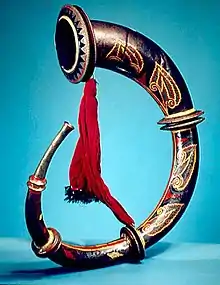
Mumbai player of tutari
The Sringa, also known as tutari, ranasringa, blowhorn, sig, singa, kurudutu or kombu, is an ancient Indian musical instrument. It is a type of horn wind instrument.[1]
Construction
There are two shape types of bugles, one made in "S" shape, and the other in "C" shape. Material was originally made of animal horn, and of metal.
Playing

Ranasringa dated to 1880, currently in the collection of the Metropolitan Museum of Art
The tutari in Maharashtra, has survived not just because of its connections to royal traditions, but as a current political symbol. The instrument is also executed in South India, in Sri Lanka, and Nepal. It is played for festivals, and in ritual performances known as kshetram vadyam. It is also played for marriages and in military music.[2][1]
See also
- Kombu (instrument)
- Ransingha. A similar instrument sharing common origin. C-shaped or S-shaped.
References
- 1 2 Das, Mohua (24 November 2019). "Sena's in the cold, but the tutari, written off many times, may still resonate". Times of India.
- ↑ Lalitha, M (19 February 2017). "The tutari's sound is a signal". The Hindu.
Sources
- S. Sadie, The New Grove Dictionary of Musical Instruments, Macmillan Publishers, London, 1985.
This article is issued from Wikipedia. The text is licensed under Creative Commons - Attribution - Sharealike. Additional terms may apply for the media files.